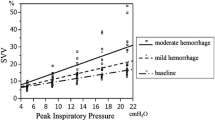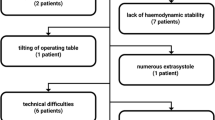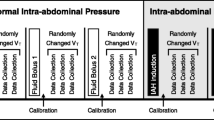Abstract
Purpose
Stroke volume variation (SVV) is affected by many factors. Although elevated intra-abdominal pressure and a pneumoperitoneum have been shown to increase SVV in animals, a recent human study showed that SVV did not change as a pneumoperitoneum was established. However, we considered the results of this study questionable, and we therefore attempted to study whether SVV changes both before and after pneumoperitoneums in humans.
Methods
We performed a prospective observational study in 19 patients undergoing cholecystectomy or colectomy while on mechanical ventilation. Immediately before pneumoperitoneum, baseline registrations of variables were obtained (baseline I), which were measured every min for 5 min after the pneumoperitoneum was initiated. Immediately before the pneumoperitoneum was released, another baseline registration of variables was obtained (baseline II); these variables were then measured every min for 5 min.
Results
After the pneumoperitoneum was initiated, there were significant increases in SVV at the 2- to 5-min time points. After release of the pneumoperitoneum, there were significant decreases in SVV at the 1- to 5-min time points.
Conclusion
A pneumoperitoneum increased SVV, which is similar to the findings of previous animal studies but is different from a previous clinical study. Upon release of the pneumoperitoneum, SVV decreased significantly, which is new information. SVV values must be estimated cautiously during a pneumoperitoneum.





Similar content being viewed by others
References
Zhang Z, Lu B, Sheng X, Jin N. Accuracy of stroke volume variation in predicting fluid responsiveness: a systematic review and meta-analysis. J Anesth. 2011;25:904–16.
Wajima Z, Shiga T, Imanaga K, Inoue T. Assessment of the effect of rapid crystalloid infusion on stroke volume variation and pleth variability index after a preoperative fast. J Clin Monit Comput. 2010;24:385–9.
Wajima Z, Shiga T, Imanaga K, Inoue T. Do induced hypertension and hypotension affect stroke volume variation in man? J Clin Anesth. 2012;24:207–11.
Wajima Z, Shiga T, Imanaga K, Inoue T. Does intravenous landiolol, a β1-adrenergic blocker, affect stroke volume variation? J Anesth. 2013;27:890–4.
Wajima Z, Tsuchida H, Shiga T, Imanaga K, Inoue T. Intravenous landiolol, a novel β1-adrenergic blocker, reduces the minimum alveolar concentration of sevoflurane in women. J Clin Anesth. 2011;23:292–6.
Biais M, Nouette-Gaulain K, Cottenceau V, Revel P, Sztark F. Uncalibrated pulse contour-derived stroke volume variation predicts fluid responsiveness in mechanically ventilated patients undergoing liver transplantation. Br J Anaesth. 2008;101:761–8.
De Backer D, Heenen S, Piagnerelli M, Koch M, Vincent J-L. Pulse pressure variations to predict fluid responsiveness: influence of tidal volume. Intensive Care Med. 2005;31:517–23.
Reuter DA, Bayerlein J, Goepfert MS, Weis FC, Kilger E, Lamm P, Goetz AE. Influence of tidal volume on left ventricular stroke volume variation measured by pulse contour analysis in mechanically ventilated patients. Intensive Care Med. 2003;29:476–80.
Duperret S, Lhuillier F, Piriou V, Vivier E, Metton O, Branche P, Annat G, Bendjelid K, Viale JP. Increased intra-abdominal pressure affects respiratory variations in arterial pressure in normovolaemic and hypovolaemic mechanically ventilated healthy pigs. Intensive Care Med. 2007;33:163–71.
Jacques D, Bendjelid K, Duperret S, Colling J, Piriou V, Viale JP. Pulse pressure variation and stroke volume variation during increased intra-abdominal pressure: an experimental study. Crit Care. 2011;15:R33.
Renner J, Gruenewald M, Quaden R, Hanss R, Meybohm P, Steinfath M, Scholz J, Bein B. Influence of increased intra-abdominal pressure on fluid responsiveness predicted by pulse pressure variation and stroke volume variation in a porcine model. Crit Care Med. 2009;37:650–8.
Valenza F, Chevallard G, Porro GA, Gattinoni L. Static and dynamic components of esophageal and central venous pressure during intra-abdominal hypertension. Crit Care Med. 2007;35:1575–81.
Høiseth LØ, Hoff IE, Myre K, Landsverk SA, Kirkeboen KA. Dynamic variables of fluid responsiveness during pneumoperitoneum and laparoscopic surgery. Acta Anaesthesiol Scand. 2012;56:777–86.
Wajima Z, Shitara T, Ishikawa G, Kaneko K, Inoue T, Ogawa R. Analgesia after upper abdominal surgery using extradural administration of a fixed dose of buprenorphine in combination with lignocaine given at two infusion rates: a comparative study. Acta Anaesthesiol Scand. 1997;41:1061–5.
Wajima Z, Shitara T, Ishikawa G, Inoue T, Ogawa R. Analgesia after upper abdominal surgery with extradural buprenorphine with lidocaine. Can J Anaesth. 1998;45:28–33.
Biais M, Vidil L, Sarrabay P, Cottenceau V, Revel P, Sztark F. Changes in stroke volume induced by passive leg raising in spontaneously breathing patients: comparison between echocardiography and Vigileo/FloTrac device. Crit Care. 2009;13:R195.
Haljamäe H. Rules of thumb. In: Hahn RG, editor. Clinical fluid therapy in the perioperative. setting ed. Cambridge: Cambridge University Press; 2011. p. 18–28.
Marik PE, Cavallazzi R, Vasu T, Hirani A. Dynamic changes in arterial waveform derived variables and fluid responsiveness in mechanically ventilated patients: a systematic review of the literature. Crit Care Med. 2009;37:2642–7.
Tournadre JP, Allaouchiche B, Cayrel V, Mathon L, Chassard D. Estimation of cardiac preload changes by systolic pressure variation in pigs undergoing pneumoperitoneum. Acta Anaesthesiol Scand. 2000;44:231–5.
Bliacheriene F, Machado SB, Fonseca EB, Otsuke D, Auler JO Jr, Michard F. Pulse pressure variation as a tool to detect hypovolaemia during pneumoperitoneum. Acta Anaesthesiol Scand. 2007;51:1268–72.
Malbrain ML, de Laet I. Functional hemodynamics and increased intra-abdominal pressure: same thresholds for different conditions…? Crit Care Med. 2009;37:781–3.
Shibutani K, Muraoka M, Shirasaki S, Kubal K, Sanchala VT, Gupte P. Do changes in end-tidal PCO2 quantitatively reflect changes in cardiac output? Anesth Analg. 1994;79:829–33.
Donati A, Munch C, Marini B, Orsetti G, Coltrinari R, Pietropaoli P. Transesophageal Doppler ultrasonography evaluation of hemodynamic changes during videolaparoscopic cholecystectomy. Minerva Anestesiol. 2002;68:549–54.
Acknowledgments
This work was conducted in the Department of Anesthesiology, International University of Health and Welfare Shioya Hospital, Tochigi, Japan. This study was supported solely by departmental resources.
Conflict of interest
No author declares any conflicts of interest.
Author information
Authors and Affiliations
Corresponding author
About this article
Cite this article
Wajima, Z., Shiga, T. & Imanaga, K. Pneumoperitoneum affects stroke volume variation in humans. J Anesth 29, 508–514 (2015). https://doi.org/10.1007/s00540-014-1963-y
Received:
Accepted:
Published:
Issue Date:
DOI: https://doi.org/10.1007/s00540-014-1963-y




